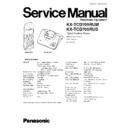Panasonic KX-TCD705RUM / KX-TCD705RUS Service Manual ▷ View online
6.1.11. BATTERY SUPPLY (SEE Fig. 27)
A switch mode boost converter is used to provide a 3.8V supply from the battery. This supply is sensed by the BBIC through
pin 26 (TP14) so that the switching rate can be controlled by a FET (T3) driven from pin 24 (TP13). A resistor on the Source
of the FET provides a current sense at pin 25 (TP12).
pin 26 (TP14) so that the switching rate can be controlled by a FET (T3) driven from pin 24 (TP13). A resistor on the Source
of the FET provides a current sense at pin 25 (TP12).
T3 switches the current through L1. When T3 switches off the back emf conducts through D16 and charges the reservoir cap
C4.
C4.
6.1.12. 2.65V REGULATOR (SEE Fig. 27)
A 2.65V supply is provided for the BBIC and is regulated by the BBIC’s on board control signal LRB (pin 37).
This reference is fed to the base of T6 to keep the “VREG+” line at 2.65V.
6.1.13. BATTERY CHARGING CIRCUIT (SEE Fig. 27)
The supply for the battery comes from the charge terminals at J3 and J4. Battery charge rate is controlled by switching the
current through T7 such that the average charging current is 170mA. The current flow is monitored at pin 49 of the BBIC by
measuring the voltage across R56.
current through T7 such that the average charging current is 170mA. The current flow is monitored at pin 49 of the BBIC by
measuring the voltage across R56.
D21 protects against the high voltage present on the charge contacts (J3 and J4) when there is no battery in the handset. R42
and C50 provide a signal to the BBIC (pin 27) to detect that the handset has been placed on the base charger.
and C50 provide a signal to the BBIC (pin 27) to detect that the handset has been placed on the base charger.
Circuit Diagram
29
KX-TCD705RUM / KX-TCD705RUS
6.2. RF SECTION
6.2.1. BLOCK DIAGRAM RF SECTION (HANDSET)
The RF section consists of two main components: The PMB6610 transceiver and the PMB6618 power amp.
In the transceiver the 10.368MHz clock signal SYCL is multiplied to around 1.9GHz using PLL (Phase Locked Loop) control.
The TXDA signal is used to control the modulation of this frequency to 1.87GHz to 1.93GHz.
The TXDA signal is used to control the modulation of this frequency to 1.87GHz to 1.93GHz.
Received signals are demodulated, filtered and sent to the BBIC via the RXDA line.
30
KX-TCD705RUM / KX-TCD705RUS
7 CHECK PROCEDURE (BASE UNIT)
7.1. EQUIPMENT REQUIRED
7.2. INITIAL POWER TESTS
1. Turn on the 9V supply.
2. Check for approx. 100mA current on the 9V supply line.
3. Check the 3.8V supply rail at TP91. It must be 3.8V ± 0.2V.
4. Check the 2.65V supply rail at TP95. It must be 2.65V ± 0.2V.
31
KX-TCD705RUM / KX-TCD705RUS
7.3. SET THE CLOCK FREQUENCY
1. Turn on the 9V supply.
2. Enter "DEACTMAC" from the PC to switch off the RF unit.
3. Enter "CONTTX 0" to start continuous RF transmission.
4. Enter "RDEEPROM 00 00 0F" to display the first 15 hexadecimal bytes of the EEPROM.
The frequency adjustment value is displayed in the first two locations with the most significant byte (MSB) first.
5. Connect the frequency counter probe to TP101, or pin12 of the RF module, to measure the SYRI signal from the BBIC.
6. The clock frequency should be within 10,368,000Hz ± 10Hz. If not then enter "SETFREQ nn nn" where nn nn are the clock
frequency adjustment values. An increase in the value will lower the clock frequency and vice versa. The maximum value is 01
FF.
FF.
7. Switch off the 9V supply.
7.4. LOOPBACK TESTS
1. Connect the RF Cable from the CMD60 to the RF 1 line (IC1 pin44) and Ground plane of the base P.C.B. Use the minimum
amount of stripped/exposed cable to solder to the contacts.
2. Switch on the 9V supply.
3. Set the CMD60 to MANUAL TEST mode.
4. Set the CMD60 TRAFFIC CARRIER to 0.
5. Invoke the "TESTMODE" batch file from the PC.
6. Press ACCEPT RFPI and SETUP CONNECT on the CMD60.
7. Check the power (NTP): it must be between 20 and 25dBm.
8. Press MODULATION.
9. Set DATA TYPE to FIG 31.
10. Check frequency drift: must be 0 ± 35 kHz/ms.
11. Check frequency offset: must be 0 ± 40 kHz.
12. Check deviation or modulation (max ± B field) with data type "FIG 31": must be 320kHz to 400kHz.
13. Press Menu Up "
↑
" on the CMD60.
14. Press POWER RAMP.
15. Check that the burst fits the mask.
16. Press Menu Up "
↑
" on the CMD60.
17. Press BER.
18. Obtain the sensitivity by slowly reducing RF LEVEL until the BER falls below 1000ppm. The sensitivity is the RF LEVEL reading
at this point. It must be < -88dBm.
19. Press Menu Up "
↑
" on the CMD60.
20. Press BEARER RELEASE and switch off the 9V supply.
21. Disconnect the RF cable from the PCB.
Note:
These tests can also be repeated on TRAFFIC CARRIERS 5 and 9.
32
KX-TCD705RUM / KX-TCD705RUS
Click on the first or last page to see other KX-TCD705RUM / KX-TCD705RUS service manuals if exist.

